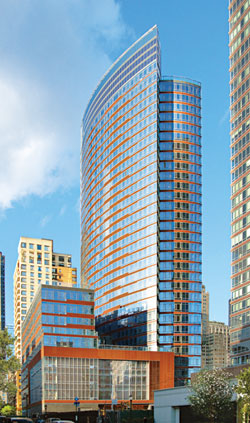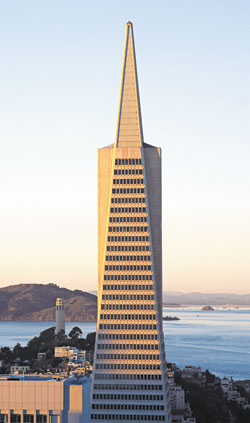The Little Engines That Can
A Microturbine at the Visionaire
 |
Microturbine waste heat warms domestic water at NYC’s Visionaire. Image: Jeff Goldberg/ESTO |
The Albanese Organization has been committed to sustainable design for many years. Working with architecture firm Pelli Clarke Pelli, the New York developer built the Solaire, which opened in 2003; the Verdesian, which debuted in 2006; and the Visionaire, which came online in 2008. All three high-rise residential buildings have been certified LEED Platinum and are located in New York's Battery Park City, which requires projects to generate enough electricity on-site to meet at least 5 percent of the base building's power needs.
Albanese begins each project holistically through an integrated design approach to achieve the highest level of energy efficiency possible for the building's particular attributes and to use the industry's most up-to-date technologies. At the Solaire, the design team met the on-site generation requirement with solar panels. For the Verdesian, both solar panels and a natural gas–fired microturbine were installed. And for the Visionaire, regenerative drive elevators, which capture the energy generated during braking, were specified in addition to the other two technologies.
The first time Albanese installed a microturbine—in the Verdesian—the developer ran into a permitting snag. “We got approval from the building department but not the fire department,” explains Michael Gubbins, Albanese vice president. The developer worked with the city of New York and the fire department for several years to establish a process for getting approval for the relatively new technology. For this reason, the microturbine in the Verdesian did not go online until 2008, the same year as the one in the Visionaire.
The design teams selected microturbines over other possible prime movers because they offered the right amounts of power and thermal energy for these residential buildings, were physically small enough to fit into their relatively small sites, and tied in well with the other building systems. Natural gas was chosen as the fuel because it is “clean, efficient, and affordable,” notes Gubbins.
The Visionaire's 69-kilowatt microturbine, which is located on one of the roof bulkheads, drives an internal generator that produces about 5 percent of the electricity needed by the base building. Another 7 percent comes from the solar panels and 2 percent from the regenerative drive elevators. The remaining energy for the base building, plus all the power for the residential units, is purchased from renewable energy sources distributed through the local utility grid.
The excess heat generated by the microturbine is transferred to a heat exchanger by water that is then circulated through a coil within an adjacent high-efficiency condensing hot water heater. Off-peak, the microturbine's waste heat is sufficient for all hot water demand. During periods of peak usage, however, the hot water heater consumes natural gas directly to heat water that has already been preheated by the waste heat.
 |
Reciprocating engines provide San Francisco's Transamerica Pyramid with up to 70 percent of its power. Photo courtesy of Transamerica Pyramid |
The Albanese teams favored packaged systems, which are prefitted by the manufacturer as needed, for ease of maintenance and anticipated longevity. Albanese staff members hold certificates of fitness to operate the microturbine, while an outside company provides maintenance.
According to Gubbins, Visionaire's microturbine cost about $100,000 and the payback will take a few years. The project received financial support for the many energy-efficient strategies incorporated into the building from both the New York State Energy Research and Development Authority and Consolidated Edison Company of New York, the local utility. Neither the Verdesian nor the Visionaire microturbines operate during blackouts, and they do not sell electricity back to the grid.
Two Reciprocating Engines at the Transamerica Pyramid
When completed in 1972, San Francisco's iconic Transamerica Pyramid drew electricity from the local utility grid and relied on city-generated steam for all its mechanical and electrical needs. But in 2005, Aegon Insurance Group, which owns the Pyramid, began looking for a more energy-efficient alternative that would reduce operating expenses.
Primarily based on its footprint and power and heating loads, Aegon decided to retrofit the 48-story, 500,000-square-foot office building with a CHP system powered by two 800-horsepower, v12 reciprocating engines running on natural gas. The engines, and their corresponding electrical generators, were specified to be in sync with the building's two main electrical switchboards.
According to Douglas Peterson, the building's chief engineer, natural gas was the logical fuel choice because its cost is historically low and it is an easy form of energy to obtain in an urban core.









